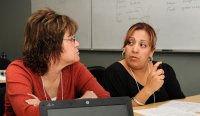How Teachers Can Learn Through Action Research
A look at one school’s action research project provides a blueprint for using this model of collaborative teacher learning.
Your content has been saved!
Go to My Saved Content.When teachers redesign learning experiences to make school more relevant to students’ lives, they can’t ignore assessment. For many teachers, the most vexing question about real-world learning experiences such as project-based learning is: How will we know what students know and can do by the end of this project?
Teachers at the Siena School in Silver Spring, Maryland, decided to figure out the assessment question by investigating their classroom practices. As a result of their action research, they now have a much deeper understanding of authentic assessment and a renewed appreciation for the power of learning together.
Their research process offers a replicable model for other schools interested in designing their own immersive professional learning. The process began with a real-world challenge and an open-ended question, involved a deep dive into research, and ended with a public showcase of findings.
Start With an Authentic Need to Know
Siena School serves about 130 students in grades 4–12 who have mild to moderate language-based learning differences, including dyslexia. Most students are one to three grade levels behind in reading.
Teachers have introduced a variety of instructional strategies, including project-based learning, to better meet students’ learning needs and also help them develop skills like collaboration and creativity. Instead of taking tests and quizzes, students demonstrate what they know in a PBL unit by making products or generating solutions.
“We were already teaching this way,” explained Simon Kanter, Siena’s director of technology. “We needed a way to measure, was authentic assessment actually effective? Does it provide meaningful feedback? Can teachers grade it fairly?”
Focus the Research Question
Across grade levels and departments, teachers considered what they wanted to learn about authentic assessment, which the late Grant Wiggins engaging, multisensory, feedback-oriented, and grounded in real-world tasks. That’s a contrast to traditional tests and quizzes, which tend to focus on recall rather than application and have little in common with how experts go about their work in disciplines like math or history.
The teachers generated a big research question: Is using authentic assessment an effective and engaging way to provide meaningful feedback for teachers and students about growth and proficiency in a variety of learning objectives, including 21st-century skills?
Take Time to Plan
Next, teachers planned authentic assessments that would generate data for their study. For example, middle school science students created prototypes of genetically modified seeds and pitched their designs to a panel of potential investors. They had to not only understand the science of germination but also apply their knowledge and defend their thinking.
In other classes, teachers planned everything from mock trials to environmental stewardship projects to assess student learning and skill development. A shared rubric helped the teachers plan high-quality assessments.
Make Sense of Data
During the data-gathering phase, students were surveyed after each project about the value of authentic assessments versus more traditional tools like tests and quizzes. Teachers also reflected after each assessment.
“We collated the data, looked for trends, and presented them back to the faculty,” Kanter said.
Among the takeaways:
- Authentic assessment generates more meaningful feedback and more opportunities for students to apply it.
- Students consider authentic assessment more engaging, with increased opportunities to be creative, make choices, and collaborate.
- Teachers are thinking more critically about creating assessments that allow for differentiation and that are applicable to students’ everyday lives.
To make their learning public, Siena hosted a colloquium on authentic assessment for other schools in the region. The school also submitted its research as part of an accreditation process with the Middle States Association.
Strategies to Share
For other schools interested in conducting action research, Kanter highlighted three key strategies.
- Focus on areas of growth, not deficiency: “This would have been less successful if we had said, ‘Our math scores are down. We need a new program to get scores up,’ Kanter said. “That puts the onus on teachers. Data collection could seem punitive. Instead, we focused on the way we already teach and thought about, how can we get more accurate feedback about how students are doing?”
- Foster a culture of inquiry: Encourage teachers to ask questions, conduct individual research, and share what they learn with colleagues. “Sometimes, one person attends a summer workshop and then shares the highlights in a short presentation. That might just be a conversation, or it might be the start of a school-wide initiative,” Kanter explained. In fact, that’s exactly how the focus on authentic assessment began.
- Build structures for teacher collaboration: Using staff meetings for shared planning and problem-solving fosters a collaborative culture. That was already in place when Siena embarked on its action research, along with informal brainstorming to support students.
For both students and staff, the deep dive into authentic assessment yielded “dramatic impact on the classroom,” Kanter added. “That’s the great part of this.”
In the past, he said, most teachers gave traditional final exams. To alleviate students’ test anxiety, teachers would support them with time for content review and strategies for study skills and test-taking.
“This year looks and feels different,” Kanter said. A week before the end of fall term, students were working hard on final products, but they weren’t cramming for exams. Teachers had time to give individual feedback to help students improve their work. “The whole climate feels way better.”
